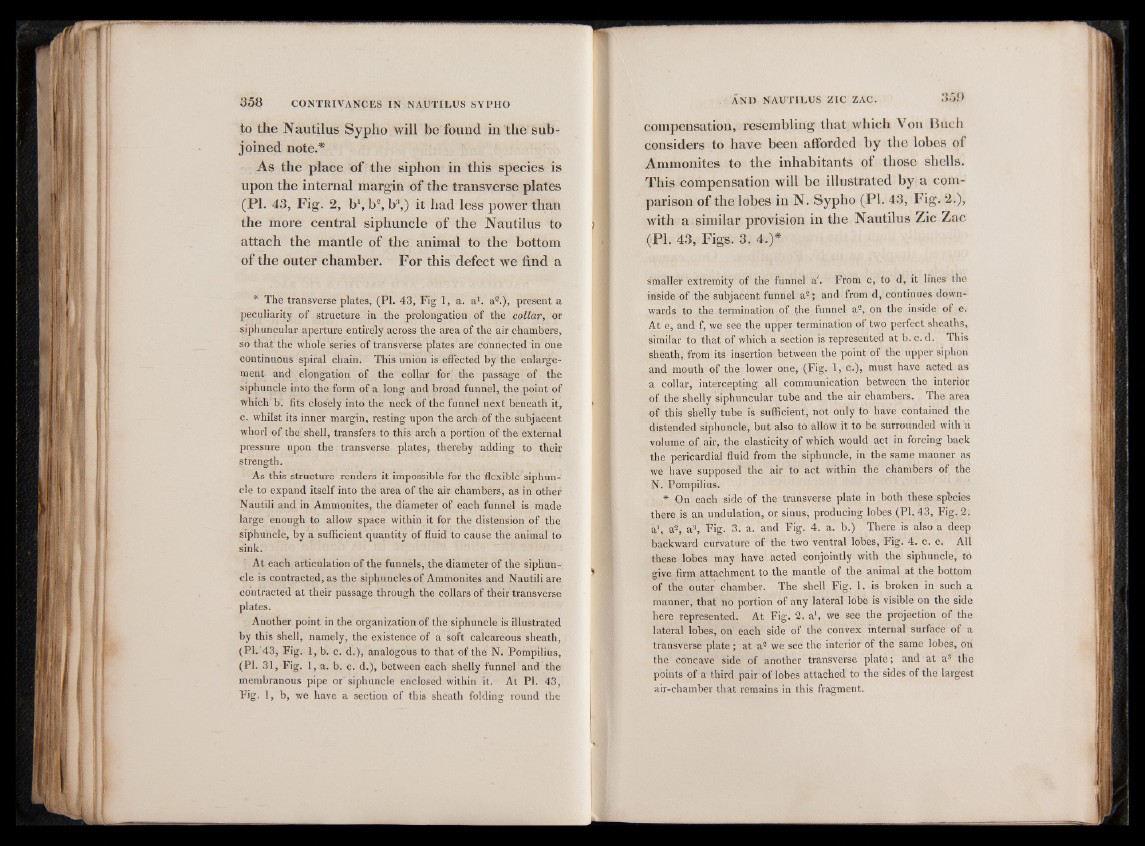
to the Nautilus Sypho will be found in the subjoined
note.*
As the place of the siphon in this species is
upon the internal margin of the transverse plates
(PI. 43, Fig. 2, b1, b2, b\) it had less power than
the more central siphuncle of the Nautilus to
attach the mantle of the animal to the bottom
of the outer chamber. For this defect we find a
* The transverse plates, (PI. 43, Fig 1, a. a1, a2.), present a
peculiarity of structure in the prolongation of the collar, or
siphuncular aperture entirely across the area of the air chambers,
so that the whole series of transverse plates are connected in one
continuous spiral chain. This union is effected by the enlargement
and elongation of the collar for the passage of the
siphuncle into the form of a long and broad funnel, the point of
which b. fits closely into the neck of the funnel next beneath it,
c. whilst its inner margin, resting upon the arch of the subjacent
whorl of the shell, transfers to this arch a portion of the external
pressure upon the transverse plates, thereby adding to their
strength.
As this structure renders it impossible for the flexible siphuncle
to expand itself into the area of the air chambers, as in other
Nautili and in Ammonites, the diameter of each funnel is made
large enough to allow space within it for the distension of the
siphuncle, by a sufficient quantity of fluid to cause the animal to
sink.
At each articulation of the funnels, the diameter of the siphuncle
is contracted, as the siphuncles of Ammonites and Nautili are
contracted at their passage through the collars of their transverse
plates.
Another point in the organization of the siphuncle is illustrated
by this shell, namely, the existence of a soft calcareous sheath,
(PI. 43, Fig. 1, b. c. d.), analogous to that of the N. Pompilius,
(PI. 31, Fig. 1, a. b. c. d.), between each shelly funnel and the
membranous pipe or siphuncle enclosed within it. At PI. 43,
Fig. 1, b, we have a section of this sheath folding round the
compensation, resembling that which Von Bucli
considers to have been afforded by the lobes of
Ammonites to the inhabitants of those shells.
This compensation will be illustrated by a comparison
of the lobes in N. Sypho (PI. 43, Fig. 2.),
with a similar provision in the Nautilus Zic Zac
(PI. 43, Figs. 3. 4.)*
smaller extremity of the funnel a'. From c, to d, it lines the
inside of the subjacent funnel a2; and from d, continues downwards
to the termination of the funnel a2, on the inside of e.
At e, and f, we see the upper termination of two perfect sheaths,
similar to that of which a section is represented at b. c. d. This
sheath, from its insertion between the point of the upper siphon
and mouth of the lower one, (Fig. 1, c.), must have acted as
a collar, intercepting all communication between the interior
of the shelly siphuncular tube and the air chambers. The area
of this shelly tube is sufficient, not only to have contained the
distended siphuncle, but also to allow it to be surrounded with a
volume of air, the elasticity of which would act in forcing back
the pericardial fluid from the siphuncle, in the same manner as
we have supposed the air to act within the chambers of the
N. Pompilius.
* On each side of the transverse plate in both these sp’ecies
there is an undulation, or sinus, producing lobes (PI. 43, Fig. 2.
a1, a2, a3, Fig. 3. a. and Fig. 4. a. b.) There is also a deep
backward curvature of the two ventral lobes, Fig. 4. c. c. All
these lobes may have acted conjointly with the siphuncle, to
give firm attachment to the mantle of the animal at the bottom
of the outer chamber. The shell Fig. 1. is broken in such a
manner, that no portion of any lateral lobe is visible on the side
here represented. At Fig. 2. a1, we see the projection of the
lateral lobes, on each side of the convex internal surface of a
transverse plate; at a2 we see the interior of the same lobes, on
the concave side of another transverse plate; and at a3 the
points of a third pair of lobes attached to the sides of the largest
air-chamber that remains in this fragment.